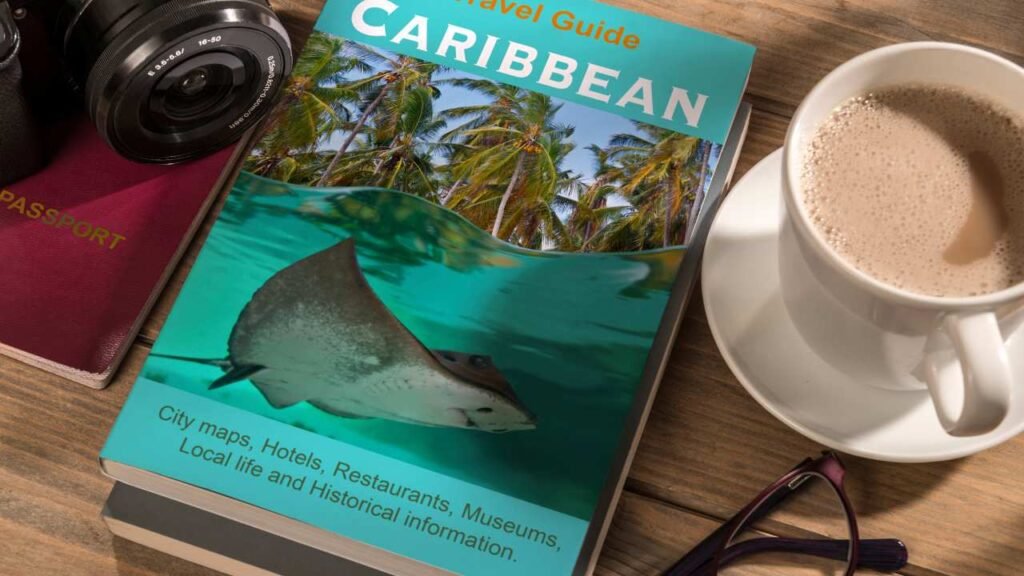Travel guide books are worth it for in-depth, curated information on destinations. They offer reliable advice and cultural context not always present online.
Embarking on an adventure to unfamiliar destinations can be both exciting and daunting. Travel guide books serve as invaluable tools for travelers seeking comprehensive insights into their chosen locales. These well-researched companions provide detailed maps, cultural etiquette tips, and handpicked recommendations that digital platforms may overlook.
They cater to various travel styles, from luxury getaways to budget backpacking, ensuring there is a guide for every type of explorer. While the digital age offers convenience, the tactile experience and ready offline access of a travel guide book add a layer of security and richness to the travel experience.
For tourists who delight in thorough preparation and wish to dive deep into the cultural fabric of new places, travel guide books remain an essential part of the journey.
Table of Contents
Toggle- The Evolution Of Travel Guide Books
- Understanding Travel Guide Books
- Pros Of Travel Guide Books
- Cons Of Travel Guide Books
- Digital Alternatives To Travel Guide Books
- Integrating Travel Guide Books And Digital Resources
- Audience Preference For Guide Books
- Environmental Impact Of Travel Guide Books
- The Role Of Guide Books In Travel Culture And Education
- The Future Of Travel Guide Books
- Making The Choice: Are Travel Guide Books Right For You?
- Frequently Asked Questions On Are Travel Guide Books Worth It
- Conclusion
The Evolution Of Travel Guide Books

The journey through time of travel guide books is an adventure in itself. This narrative explores the transformation from ancient scrolls to digital apps. Delve into the history and tech-savvy future of travel planning.
From Parchment To Print: A History Of Travel Guides
The tale begins with parchments and scrolls. Explorers documented new lands, creating the first guides. These texts were rare, handwritten, and reserved for the elite.
As time progressed, printing presses emerged. This led to mass-produced guidebooks. Everyone could now dream of distant shores. The iconic names like Baedeker and Murray became synonymous with travel adventures.
By the 20th century, travel guides were on every bookshelf. Guides like Lonely Planet and Frommer’s shaped modern tourism. They became travel’s holy grail, offering wisdom on culture, history, and practical tips.
The Digital Revolution: How Technology Transformed Travel Information
The internet arrived and changed everything. Physical books met digital magic. Information became instant and easily updated, making travel more dynamic.
Travel apps and websites brought forth a new era. TripAdvisor and Google Trips became the norm. They provided real-time updates, reviews, and navigation.
Interactive maps and translation tools became invaluable. Travelers could now carry a world of information in their pockets. Customization and convenience redefined the way we explore.
Understanding Travel Guide Books

When travelers plan a trip, they often seek a trusty companion. This companion is a travel guide book. Travel guide books offer vast troves of knowledge, packed with advice, directions, and inspiration.
Defining The Travel Guide Book: Purposes And Content
A travel guide book is a resource packed with information for travelers. It helps with planning and during the trip. Guide books have maps, tips, and cultural insights. They serve as a roadmap to unknown places.
- Destination highlights: Top spots to see.
- Itineraries: Planned routes for various trip lengths.
- Local secrets and tips: Dining, shopping, and hidden gems.
- Cultural background: History and cultural customs.
- Practical information: Accommodation, transport, and costs.
Different Types Of Travel Guides: From Lonely Planet To Fodor’s
Travel guides come in different shapes. Some are for budget travelers. Others are for luxury seekers.
| Guide Book | Audience | Focus |
|---|---|---|
| Lonely Planet | Backpackers and budget travelers | Off-the-beaten-path experiences |
| Fodor’s | Cultural and historic interest travelers | Rich and detailed cultural insights |
| Rick Steves | First-time Europe visitors | Practical advice for European travel |
| Frommer’s | Mixed audience | Range from budget to deluxe tips |
Some guides, like Lonely Planet, attract adventurers. Places less traveled, more adventure. Fodor’s attracts those who love details and stories. These books focus on sights’ history and cultural significance.
For European journeys, Rick Steves is a favorite. His books offer practical routes and tips. Frommer’s supports a wider range of travel styles. From shoestring budgets to luxury experiences, all can find help in its pages.
Pros Of Travel Guide Books

Travel guide books offer an incomparable charm and utility to travelers keen on immersing themselves in new destinations. With digital alternatives gaining traction, the inherent benefits of physical travel guides should not be dismissed.
Each page turn reveals carefully curated knowledge that can enrich any journey, serving as a reliable companion on even the most remote adventures. Let’s explore some of the undeniable advantages of choosing a travel guide book for your next trip.
Benefits Of Paper-based Guides: Tangibility And Reliability
There’s something special about the feel of a book in your hands. Travel guide books are concrete resources that can withstand the trials of travel. They don’t need power or an internet connection, making them hugely reliable when technology might fail. With a physical guide book, you’ll have instant access to maps, recommendations, and itineraries without worrying about battery life. These guides become keepsakes, riddled with personal notes and bookmarks that tell the story of your travels long after you return home.
- Don’t require charging or Wi-Fi
- Resilient against travel mishaps
- Instant access to essential information
In-depth Information: Why Detail Matters In Travel Planning
Guide books often offer meticulously detailed insights unmatched by quick online searches. Authors spend months, even years, compiling the best experiences, eateries, and hidden gems. This thoroughness ensures that travelers can plan with a level of detail that often surpasses digital sources.
Whether it’s opening hours for attractions, prices for local delicacies, or understanding transport options, the depth provided helps travelers plan effectively for a hassle-free experience.
Cultural Insights And Tips: Learning Through Local Perspectives
For those eager to dive deep into the local culture, travel guide books are treasure troves of information. They often contain tips and anecdotes from locals, offering unique cultural insights.
You’ll find customs explained, etiquette unraveled, and cultural festivals highlighted, allowing for an authentic experience. Guide books help travelers avoid common faux pas and embrace practices that deepen their connection to the destination.
- Etiquette and customs guidelines
- Local festivals and events
- Insider knowledge for authentic experiences
Cons Of Travel Guide Books
Travel guide books have been loyal companions to adventurers for generations. Yet, in the modern era of travel, they face numerous criticisms. Let’s unpack some of the drawbacks that often leave travelers contemplating their necessity.
Lack Of Up-to-date Information: Navigating Obsolescence
Information changes rapidly, and guide books can struggle to keep pace. Points of interest may have altered opening hours, prices, or may no longer exist. This leads to frustration for travelers relying on printed advice.
Bulk And Weight: The Inconvenience Of Carrying Books
Guide books add extra weight to your luggage. This can be cumbersome for travelers attempting to pack light. Carrying several books is not practical when you need to stay mobile.
Cost Considerations: Is The Investment Worth It?
Travel guides are not always cheap. Before purchasing, savvy travelers assess if digital alternatives offer more value. Here are some cost-related considerations:
- Price: Buying multiple books for various destinations adds up.
- Usage: How often will you use the guide book?
- Resale: Once the trip ends, the resale value of guide books is low.
Digital Alternatives To Travel Guide Books
Let’s dive into the world of digital alternatives to travel guide books. Gone are the days when travelers clung tightly to their paperback guides. Now, a wealth of knowledge fits in the palm of your hand. Smartphones and digital devices offer real-time, interactive travel information. This can change the way adventurers explore new destinations.
Travel Websites And Apps: A New Age Of On-demand Information
The rise of travel websites and apps offers an on-demand, interactive guide to the world. They provide custom recommendations. Users can filter searches for tailored results. Here’s why they’re game changers:
- Real-time updates: Get the latest info on attractions and prices.
- Interactive maps: Navigate new places with ease.
- User reviews: Read experiences shared by fellow travelers.
- Offline access: Some apps work without internet.
- Travel planning: Book hotels, flights, and tours in-app.
The Role Of Social Media And Blogs In Modern Travel Planning
Social media and travel blogs have transformed travel planning. They provide a personal touch to travel insights. Here’s how they make a difference:
| Platform | Benefits |
|---|---|
| Instagram/Facebook | Visual inspiration, latest trends, traveler communities |
| Quick updates, news alerts, travel tips | |
| Boards for trip ideas, links to guides and blogs | |
| Travel blogs | Detailed articles, first-hand experiences, niche advice |
Readers engage directly with bloggers and fellow travelers. They gain insights and advice from those on the road right now. Social media also sparks conversation. Like, share, and comment to join the global travel community.
Integrating Travel Guide Books And Digital Resources
In the age of smartphones, some travelers question the usefulness of physical travel guidebooks. This section delves into the benefits of combining the detailed, curated information in guidebooks with the up-to-date, interactive capabilities of digital tools. This multi-faceted approach can enhance travel experiences. Let’s explore how to integrate these resources for efficient trip planning.
Complementing Books With Digital Tools For A Holistic Approach
Travel guidebooks offer insights that digital resources might miss. They come from authors with in-depth local knowledge. Digital tools, such as apps and websites, provide real-time updates. Joining the two creates a powerful toolkit for any traveler. Below are ways to blend these resources:
- Use guidebooks for thorough background information on destinations.
- Download travel apps for current events, bookings, and navigation.
- Turn to social media for the latest traveler reviews and tips.
- Keep digital copies of guidebook pages for easy reference.
- Create a travel itinerary using guidebook suggestions and digital tools.
Case Studies: Successful Blended Travel Planning Strategies
Diverse travel experiences reveal how combining guidebooks with digital resources leads to well-rounded adventures. Here are some real-world examples:
| Traveler Type | Guidebook Use | Digital Resource Use | Outcome |
|---|---|---|---|
| Solo Backpacker | Destination history, cultural norms | Hostel bookings, GPS navigation | Authentic, smooth journey |
| Family Vacationers | Family-friendly activities, budget tips | Weather forecasts, online discounts | Fun, cost-effective trip |
| Adventure Seeker | Off-the-beaten-path spots | Adventure sports bookings, survival guides | Thrilling, safe experience |
Audience Preference For Guide Books
In a world brimming with digital information, travel guide books maintain a nostalgic grip on the hearts of many voyagers. From glossy pages to tidbits of local wisdom, let’s explore who still cherishes these travel bibles and why they remain relevant to certain demographics.
Who Prefers Physical Books? Demographics And Psychographics
Physical travel guide books appeal to a unique set of readers. These enthusiasts value tangibility, a break from screen time, and often belong to age groups that relish traditional reading methods. Personal preferences and behaviors influence their choice towards physical guide books.
| Age Group | Preference | Behaviors |
|---|---|---|
| 50+ | Strong Preference | Nostalgia, Printed Map Use |
| 30-49 | Moderate Preference | Blend of Digital and Print |
| 18-29 | Lesser Preference | Digital Native, Eco-conscious |
Survey Results: Reasons For Continued Popularity Among Certain Travelers
Surveys shed light on why travel guide books still captivate a segment of travelers. From the tactile experience to the joy of annotations, these books offer something that pixels on a screen can’t.
- Tactile Feel: Many relish the feel of paper and the ease of flipping through pages.
- Annotations: Writing notes and bookmarks personalize the travel experience.
- No Battery Concerns: Guide books offer reliability with no need to charge.
- Ease of Use: Quick reference during travel without the need for Wi-Fi.
- Curation: Expertly curated content provides a sense of trust and authority.
The appeal is clear: a physical guide book represents independence from technology, presenting a self-contained trove of travel knowledge that many find indispensable.
Environmental Impact Of Travel Guide Books
Travel guide books offer valuable insights for explorers. Yet, these physical books carry an environmental price. This section dives into the ecological footprint they leave behind. Understanding this footprint is vital for eco-conscious travelers.
The Carbon Footprint Of Printing And Distributing Physical Books
Every travel guide book starts with paper and ink. These materials come from trees and various chemical compounds. The process emits carbon dioxide (CO2).
Transporting these books also contributes to CO2 emissions. Trucks, ships, and planes that deliver books burn fossil fuels. This process harms our planet’s health.
| Material | Environmental Cost |
|---|---|
| Paper | Deforestation, water use |
| Ink | Chemical pollution |
| Transport | CO2 emissions |
Sustainable Travel: Opting For Greener Alternatives
Digital travel guides present an eco-friendlier choice. Travelers can access these guides on phones, tablets, and laptops. This choice reduces the demand for paper and ink.
Using digital guides also slashes the need for physical distribution. CO2 emissions from transport decrease significantly.
- No paper waste
- Lower carbon emissions
- Instant access to updates
Choosing digital aids in protecting our environment. Travelers embrace sustainability when they opt for these alternatives. They still discover the wonders of new places, responsibly.
The Role Of Guide Books In Travel Culture And Education
Travel guide books have a rich history. They shape how we see the world. They teach us about new places. Many travelers keep guide books close. These books are cultural bridges. They are also educational tools.
Inspiring Wanderlust: How Guide Books Fuel The Desire To Explore
Have you ever dreamt of distant lands? Travel guide books paint pictures with words. They show us exotic places. We learn about festivals, foods, and history. These books turn dreams into plans. They make us yearn to travel.
- Vivid Descriptions: Guide books use thrilling stories. They make us feel the adventure.
- Beautiful Imagery: Photos in guide books catch our eyes. They invite us into new worlds.
- Personal Tales: Authors share their journeys. They become templates for our own.
Travel Guide Books As Educational Tools: Beyond Just Itineraries
Guide books are more than travel tips. They educate us on different cultures. They dive into history. You learn local customs. They share etiquette to follow.
| Feature | Educational Benefit |
|---|---|
| Local Laws | Learns about rules to respect. |
| Historical Context | Understands a place’s past. |
| Cultural Insights | Discovers traditions and values. |
| Language Tips | Gets familiar with key phrases. |
Books inspire kids and adults to learn geography. They break down barriers. They turn us into global citizens. They are not just books, but passports to wisdom.
The Future Of Travel Guide Books
With the digital age advancing, travel guide books face a critical moment. Will they stay relevant? Many travelers still cherish the physical book, filled with insights and tips that make adventures memorable. Yet, the question remains: can these tangible travel companions keep up with the high-speed train of technological innovation? In this article, we explore how travel guides are evolving and their place in tomorrow’s travels.
Adapting To Change: How Guide Book Publishers Are Innovating
The shift to digital isn’t the end for travel guide books; it’s a new chapter. Publishers embrace innovation to stay in the game. Here is how they do it:
- Interactive eBooks: Enhancing traditional content with interactive maps and links.
- Mobile Apps: Offering handy travel information right on your smartphone.
- Online Communities: Connecting travelers to share experiences and advice.
Such moves keep guide books practical and engaging. With additional features like clickable recommendations, they provide a blend of nostalgia and new-age convenience.
Predictions: The Relevance Of Guide Books In A Fast-paced World
Despite the rise of instant online resources, travel guide books maintain a unique charm. They offer curated, reliable information that online sources often lack. Looking ahead, predictions include:
| Trend | Impact on Guide Books |
|---|---|
| Nostalgia Marketing | Increases desire for physical books as keepsakes. |
| Information Overload | Encourages trust in edited, concise guides. |
| Eco-Friendly Practices | Promotes sustainable travel editions and materials. |
The future suggests that travel guide books will remain relevant as a trusted companion for those looking to dig deeper into their travel experiences, complementing the digital resources that offer up-to-the-minute updates.
Making The Choice: Are Travel Guide Books Right For You?
Embarking on a journey can stir a mix of excitement and uncertainty. Travel guide books offer a remedy, packed with insights and tips. They lead travelers through unfamiliar streets and cultures. But in a digital age, where information is readily available online, a question stands: Do you really need a guide book in your backpack?
Personal Preferences And Travel Styles: A Self-assessment
Consider your travel habits and tech comfort level. Some adore the tangibility of pages, while others prefer a screen. Are spontaneity and serendipitous discoveries at the top of your list? Or do detailed plans ease your mind? Your preference will heavily influence your choice.
- Individual comfort: Do physical books or electronic devices work better for you?
- Travel pace: Are you a slow wanderer or a fast-paced sightseer?
- Tech-savviness: Is navigating apps and online maps second nature to you?
The Verdict: Weighing The Pros And Cons For Your Next Trip
Travel guide books come with their own set of advantages and drawbacks. Let’s lay them out to determine if they align with your expectations and needs.
| Pros | Cons |
|---|---|
| Credibility: Trusted authors and experts compile the content. | Weight: Books can be bulky to carry. |
| Comprehensive: They offer extensive knowledge about destinations. | Cost: They can be an additional expense. |
| Offline utility: No need for internet or battery power. | Updates: Information may not be current. |
Evaluate these points in the context of your journey. Can you overlook the weight for credible, in-depth knowledge? Are up-to-date recommendations a must? The answers will shape your decision.
Ultimately, the choice lies in syncing your travel style with the right information source. Guidebooks may just be the travel buddy you’re looking for, or perhaps a digital alternative fits your dynamic itinerary better. Assess, compare, and gear up for your adventure your way!
Frequently Asked Questions On Are Travel Guide Books Worth It
Do People Still Use Travel Guide Books?
Yes, despite the digital age, many travelers still use printed travel guide books for reliable information and convenient offline access.
What Are The Benefits Of Travel Guide Books?
Travel guide books offer curated information, local insights, important landmarks, and insider tips. They provide convenient offline access and help plan itineraries effectively.
Are Travel Guides Useful?
Travel guides are indeed useful; they provide insightful tips, cultural etiquette, and can help save time by prioritizing key attractions.
Do I Need A Guidebook?
A guidebook isn’t necessary but can enhance your trip by providing historical context and practical tips. For a tech-savvy traveler, digital resources may suffice.
Conclusion
Exploring new destinations is truly exhilarating. Travel guide books offer expertise and insights that deepen this joy. They’re valuable companions for cultural enrichment and practical navigation. Even in the digital age, the tangible benefits of having a trusted book in hand cannot be undervalued.
Bind your travels with the wisdom of guide books.



